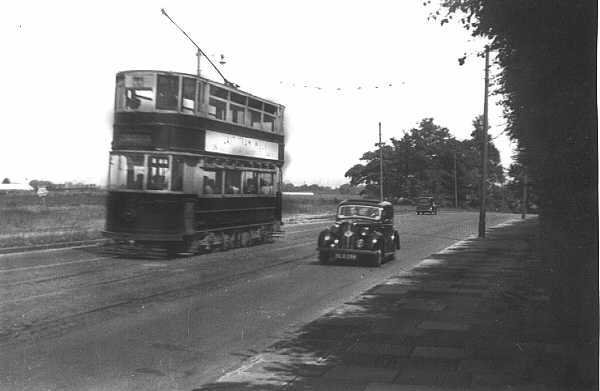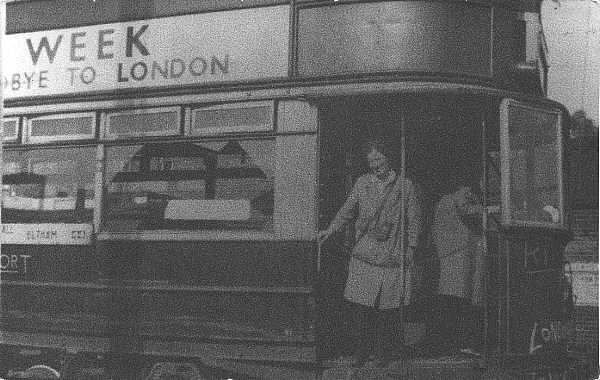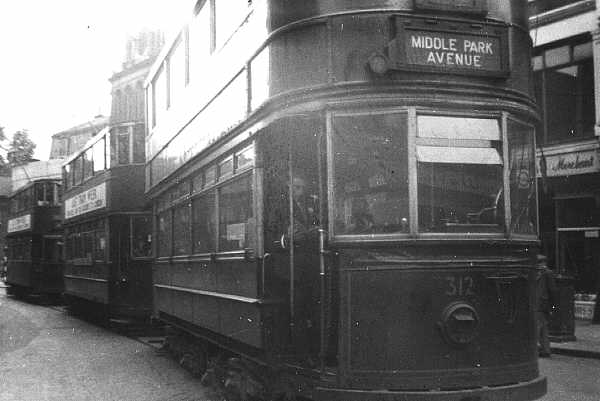

| Tram on service 44 on Academy Road during last tram week It was
said the trams caused road congestion. This road doesn't look very congested,
one tram and two cars. At this spot today there is usually a line of traffic
waiting for the lights at Shooters Hill, in rush hours it stretches way
down the hill. It was so bad that there is now a bus priority lane.
Photograph. W. D. Chalklin |

|
|
| Ever since 1917 when the first complete electric tramway system was
abandoned —at Sheerness — the ‘last car’ ceremonies enacted in dozens of
cities and towns have invariably drawn crowds; some to cheer the passing
of what they considered abominations, others to watch in silence and, perhaps,
regret. For trams were friendly vehicles and in their heyday were a cause
for civic pride, a symbol of up-to-date thinking at the Town Hall. In the
years before the first World War the electric tram reigned supreme, but
in sixty years or so it arrived, conquered and was finally all but vanquished
by the trolleybus and the motor bus.
In the London area the tramways reached a maximum of 345 route miles served by over 2,600 cars — the largest network in the country — but after the successful introduction of trolleybuses by the London United Tramways in 1931 and the formation of the London Passenger Transport Board in 1933, tramscrapping began in earnest. By June 1940 the whole of the North London tram routes had been converted to trolleybus operation with the exception of two spurs to Highgate and Manor House via the Kingsway Subway. All subsequent abandonment’s were shelved until after the war when it was decreed that the diesel bus was to be the favoured mode of travel. In 1946 London Transport announced the resumption of its tram scrapping programme and this was carried out in eight stages starting in September 1950. In preparation for this a large site was acquired at Penhall Road Charlton in South East London and laid out with a number of parallel tracks on which the displaced trains were stored as they came out of service. After stripping them of all useful parts the bodies were burned. In every case, except one, the changeover from trams to buses was made on a Saturday night, the buses taking over on Sunday morning; in some districts official ‘last trams’ were run and people made a night of it, civic dignitaries and local organisations contributing to the ceremonies. From LP cover. London's last trams. Argo records. The last day of London's trams was July 5 1952. Within 10 years the trollybuses followed them to the scrapyard. The last London trolleybus ran on 8 May 1962. Woolwich lost its trolleybuses in March 1959, in the first stage of scrapping. Plans were in hand before the war to convert all South London tram routes to trolleybuses, but the war brought this to a halt. The new route numbers would have been achieved by adding a 5 to the tram route number. Plans were to have North London routes starting with a 6 and South London with a 5. For more details follow: |

| Last tram week in Woolwich New Road the terminus for the Eltham
routes 44 and 46.
car 312 an ex West Ham car doesn't have room for the 'Last Tram Week' poster on its side. |
| Stage and date | Routes withdrawn. |
| Stage 1 - 30 September 1950 | 12, 26, 28, 31, 34, 3 (all night) |
| Stage 2 - 6 January 1951 | 2 & 4, 6,10, 8 & 20, 22 & 24, 1 (all night) |
| Stage 3 - 7 April 1951 | 16 & 18, 42 |
| Stage 4 - 10 July 1951 | 68, 70 |
| Stage 5 - 6 October 1951 | 56 & 84, 58, 60, 62, 66, 7 (all night) |
| Stage 6 - 5 January 1952 | 48, 52, 54, 74, 78, 5 (all night) |
| Stage 7 - 5 April 1952 | 33, 35, 35 (all night) |
| Stage 8 - 5 July 1952 | 36, 38, 40, 44, 46, 72 |
|
After London scrapped its trams there were twelve towns left with them. Aberdeen, Belfast, Birmingham, Blackpool, Dundee, Edinburgh, Glasgow, Leeds, Liverpool, Sheffield, Sunderland, and Swansea. Only Blackpool is left. There are moves now to reintroduce trams to our towns, for the very same reason that was given for scrapping them, to ease congestion on the streets. In London, Croydon was the first place with services starting in 2000, running over old railway track alignments outside the town, but along the streets in the town centre. More information can be found in ''London Tramways' by John Reed. See book list. |
This page was designed and is maintained
by Toby and John King, I would accept any comments or questions See
Index Page